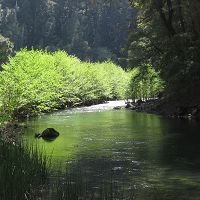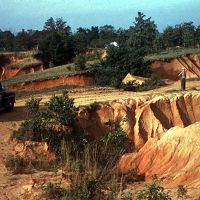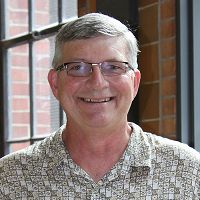Introducing Intensively Managed Landscapes (IML) CZO
The landscape of the Upper Midwest is among the most altered in North America. After the glaciers retreated, centuries of prairie plants created the layer of rich organic material that is now the region's famously productive farmland. But after more than a century of intensive plowing, erosion, and artificial drainage, the tallgrass prairie has been transformed into a checkerboard of farm fields, extensively drained by underground tiles discharging into straightened dredged ditches. As an example, less than one-tenth of one percent of Iowa’s original tallgrass prairie is left untilled, ranking the state 50th in the nation in total uncultivated land remaining.
This transformation has made midwestern states leaders in agricultural production, but it has had many other far-reaching effects as well, particularly for the “critical zone.” The critical zone is the region from the treetops into the bedrock aquifers, including the Midwest's layer of rich topsoil, where the atmosphere, biosphere, and geosphere interact to sustain life. A National Science Foundation-supported research effort to understand and stabilize the critical zone is underway at 10 research centers nationwide, including the University of Iowa and the University of Illinois at Urbana-Champaign.
A Big Ten Partnership
The Critical Zone Observatory for Intensively Managed Landscapes (IML-CZO) is led by the University of Illinois at Urbana-Champaign and includes partners from the University of Iowa and four other Big Ten universities (Purdue, Northwestern, Minnesota, and Penn State). The majority of the research will focus on the Clear Creek Watershed near Iowa City, Iowa, and the Upper Sangamon River Basin in Illinois. These watersheds are fundamental in analyzing, quantifying, and understanding critical zone processes that can then be extrapolated to other areas of the country. Researchers will conduct experiments in the field and monitor baseline characteristics by placing sensors in the basins, while also collecting samples and data to understand how sediments, water, and nutrients flow through the system. Previously collected data will offer a historical context, particularly in the Clear Creek watershed, where more than a decade of information is already available. With this information, researchers will be able to build a very detailed and inclusive understanding of the processes at work in the system.
Human Impact on the Critical Zone
Praveen Kumar, who leads the $4.9M Iowa/Illinois partnership, says this research offers a unique opportunity to understand the impact of humans on the critical zone. Kumar, a professor of civil and environmental engineering at the University of Illinois at Urbana-Champaign, says, “The observatory is aimed at understanding how natural processes happen together, how they co-evolve, and how human modification has altered that,” Kumar says. “What is the limit to these modifications and what do we need to do to recover many of the functions that originally made this land productive?”
IML-CZO co-director Thanos Papanicolaou, professor of civil and environmental engineering at the University of Tennessee-Knoxville, says that in the Midwest, we have a unique opportunity to study the critical zone in an intensely managed landscape. Papanicolaou says he wants to understand how much we have already degraded the critical zone resources. In addition, he hopes to learn:
- How much time do we have left before the system is exhausted, operating under current conditions?
- How can we stabilize the critical zone?
- What new science and engineering tools can we develop to return the system to a healthier state?
An Interconnected System
Researchers expect the project to be groundbreaking, says co-PI Art Bettis, an associate professor of earth and environmental sciences at the University of Iowa, and an associate research engineer at IIHR—Hydroscience & Engineering (a research institute at the Iowa College of Engineering). Up until now, he says, researchers have not been able to study the critical zone holistically. “It’s a system. The only way to understand a system is by looking at all of its parts, and the interconnections between them,” Bettis explains.
By necessity, this effort is also highly interdisciplinary. The CZO research brings together researchers from a number of fields to cooperate and collaborate, and that can be a challenge in itself, Bettis says. “We benefit as much from that exercise as we do from a lot of the science.”
The IML-CZO project will continue for at least five years. This extended time frame fosters experimentation and encourages asking complex and difficult questions. It also encourages cooperation among researchers, as they learn to communicate and collaborate effectively across disciplinary boundaries.
Pure Science, Practical Applications
IML-CZO researchers conduct deep, pure scientific research that could also have immediate practical applications. Team members will work with cooperative agencies, such as county conservation boards, that in turn work with landowners and farmers to test new best management practices (BMPs). Many of these are already at work in the Clear Creek watershed, so scientists can monitor the effects of BMPs to see how well they function in the real world.
The IML-CZO is unique among the CZO sites nationwide in that it focuses on agricultural and urban landscapes. Researchers here will be able to study the ag-urban transition zone in a new way. “Human influence is the wildcard here,” Bettis says. “Particularly in the intensively managed landscapes of the Midwest, human activity has a disproportionate impact on the critical zone processes, and raises important issues not addressed at other observatories in the NSF-CZO network.”
Papanicolaou says the investment made by NSF to create the new IML-CZO indicates just how important it is to understand the system. “The ideal outcome would be for us to understand what actions we need to take as humans to sustain this environment.”
The IML-CZO team includes researchers from a number of academic disciplines:
PI and Co-PIs
- Praveen Kumar, Principal Investigator, University of Illinois Department of Civil and Environmental Engineering (kumar1@illinois.edu)
- Art Bettis, Co-PI, University of Iowa Department of Earth and Environmental Sciences (art-bettis@uiowa.edu)
- Thanos Papanicolaou, Co-PI, University of Tennessee-Knoxville Department of Civil and Environmental Engineering (tpapanic@utk.edu)
- Tim Filley, Co-PI, Purdue University (filley@purdue.edu)
- Alison Anders, Co-PI, University of Illinois (amanders@illinois.edu)
University of Illinois
- Alison M Anders, University of Illinois Department of Geology (amanders@illinois.edu)
- Marcelo Garcia, University of Illinois Department of Civil and Environmental Engineering (mhgarcia@illinois.edu)
- David Grimley, Illinois State Geological Survey, Prairie Research Institute (dgrimley@illinois.edu)
- Laura Keefer, Illinois State Water Survey, Prairie Research Institute (lkeefer@illinois.edu)
- Don Keefer, Illinois State Geological Survey, Prairie Research Institute (dkeefer@illinois.edu)
- Charu Kumar, University of Illinois Department of Bioengineering (cgkumar@illinois.edu)
- Yu-Feng Lin, Illinois State Geological Survey, Prairie Research Institute (yflin@illinois.edu)
- Luigi Marini, National Center for Supercomputing Applications, University of Illinois (lmarini@illinois.edu)
- Gary Parker, University of Illinois Department of Civil and Environmental Engineering (parkerg@illinois.edu)
- Joshua Peschel, University of Illinois Department of Civil and Environmental Engineering (peschel@illinois.edu)
- Andrew Phllips, Illinois State Geological Survey, Prairie Research Institute (aphillps@illinois.edu)
- Bruce Rhoads, University of Illinois Department of Geography and Geographic Information Science (brhoads@illinois.edu)
University of Tennessee
- Thanos Papanicolaou, University of Tennessee Department of Civil and Environmental Engineering (tpapanic@utk.edu)
University of Iowa
- Elmer Bettis III, University of Iowa Department of Earth and Environmental Science, IIHR—Hydroscience & Engineering (art-bettis@uiowa.edu)
- Witold Krajewski, University of Iowa Department of Civil and Environmental Engineering, IIHR—Hydroscience & Engineering (witold-krajewski@uiowa.edu)
- Marian Muste, IIHR—Hydroscience & Engineering, University of Iowa (marian-muste@uiowa.edu)
- Douglas Schnoebelen, IIHR—Hydroscience & Engineering, University of Iowa (doug-schnoebelen@uiowa.edu)
- Adam Ward, University of Iowa Department of Earth and Environmental Science, IIHR—Hydroscience & Engineering (adam-ward@uiowa.edu)
- Larry Weber, University of Iowa Department of Civil and Environmental Engineering, IIHR—Hydroscience & Engineering (larry-weber@uiowa.edu)
- Christopher Wilson, IIHR—Hydroscience & Engineering, University of Iowa (christopher-wilson@uiowa.edu)
Purdue University
- Inderjeet Chaubey, Purdue University Department of Agricultural and Biological Engineering (ichaubey@purdue.edu)
- Timothy Filley, Purdue University Department of Earth, Atmospheric, and Planetary Sciences (filley@purdue.edu)
Northwestern University
- Neal Blair, Northwestern University Department of Civil Engineering, and Department of Earth and Planetary Science (n-blair@northwestern.edu)
- Andrew Jacobson, Northwestern University Department of Earth and Planetary Science (adj@earth.northwestern.edu)
- Aaron Packman, Northwestern University Department of Civil and Environmental Engineering (a-packman@northwestern.edu)
University of Minnesota
- Barbara Burkholder, St. Anthony Falls Laboratory, University of Minnesota (bkb0811@umn.edu)
- Efi Foufoula-Georgiou, St. Anthony Falls Laboratory, University of Minnesota (efi@umn.edu)
Pennsylvania State University
- Henry Lin, Penn State University Department of Ecosystem Science and Management (henrylin@psu.edu)
- Juan Quijano, Penn State University Department of Ecosystem Science and Management (jcq3@psu.edu)
Utah State University
- Patrick Belmont, Utah State University Department of Watershed Science (patrick.belmont@usu.edu)
For further details about the project, visit: http://imlczo.org.
News Category:
RESEARCH |
INFRASTRUCTURE |
PEOPLE
People Involved
CZO
-
IML, INVESTIGATOR
-
IML, INVESTIGATOR
-
IML, INVESTIGATOR
-
IML, INVESTIGATOR
-
IML, INVESTIGATOR
Partner Organizations
Related News

New CZOs formally unveiled
17 Jan 2014 - The National Science Foundation formally announced the funding of four new Critical Zone Observatories to be added to expand the network to a total...

Introducing Eel River CZO
03 Mar 2014 - UC Berkeley scientists will receive $4,900,000 over the next five years to study the Eel River watershed in Northern California...

Introducing Calhoun CZO
03 Mar 2014 - The Calhoun CZO seeks to understand how Earth’s Critical Zones respond to and recover from severe erosion and land degradation.

Introducing Reynolds Creek CZO
03 Mar 2014 - New Reynolds Creek CZO leverages USDA ARS spatial and temporal hydroclimate data to improve prediction of soil carbon and critical zone processes
Explore Further











